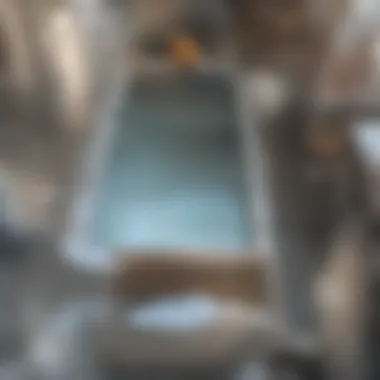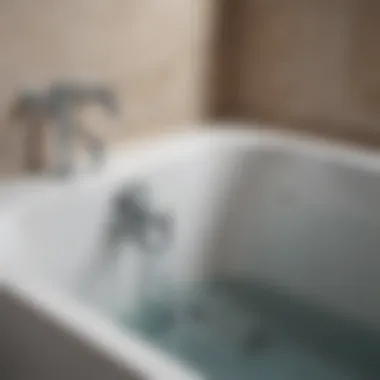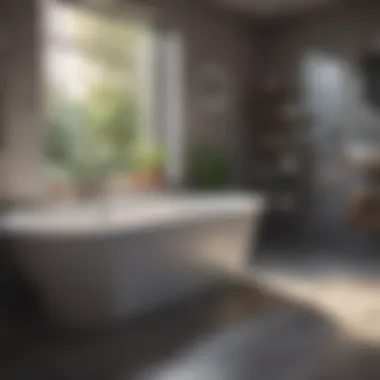Understanding Water Issues in Bathtubs: Dive Deep


Intro
Water issues in bathtubs can cause frustration for homeowners. Often, the source of these problems traces back to the drain water discharge system. Understanding how this system operates is crucial for identifying issues and preventing costly repairs. This guide will analyze the nature of these water issues, covering both the mechanics of drainage systems and the impact of plumbing design.
By breaking down common and uncommon causes of water discharge from bathtubs, readers can become aware of potential maintenance practices and necessary interventions. Equipped with this knowledge, homeowners will have the tools to manage their plumbing efficiently. This article aims to be comprehensive but accessible, giving a blend of technical insights and practical advice.
Architectural Inspiration
Overview of Design Styles
The style of a bathtub can greatly influence its drainage system. Different architectural designs have differing requirements for water discharge. Traditional designs often employ straightforward gravity-based systems, while modern styles may integrate advanced technology to facilitate water management. This interplay between design and function is significant. Understanding how architectural choices affect drainage can guide homeowners in making informed decisions about renovations or purchases.
Innovative Materials and Techniques
Materials play a crucial role in the efficacy of bathtub drainage. High-quality materials ensure durability and functionality, while innovative techniques can enhance efficiency. Contemporary bathtubs may use flexible plumbing technology, reducing the likelihood of blockages and leaks. This approach can impact water discharge, making it essential for homeowners to consider material quality. Investing in products that prioritize both aesthetics and function can lead to a significant reduction in drainage issues over time.
"Investing in innovative materials can prolong the life of your plumbing systems and enhance functionality."
Common Drain Issues
Common issues that arise in bathtub drainage include clogs, slow drainage, and unexpected water backflow. Clogs can develop from hair, soap residue, and other debris accumulating in the pipes. Homeowners must conduct regular maintenance to prevent these issues.
Tips for Avoiding Clogs
- Use a drain cover: Captures debris before it enters the plumbing.
- Regular flushing: Pour hot water down the drain to clear minor blockages.
- Limit waste: Reduce the amount of soap and hair reaching the drain.
Impact of Plumbing Design
The plumbing design significantly impacts how water is discharged from bathtubs. Poorly designed systems can create pressure points or areas where water tends to pool. Homeowners should consider the layout, pipe size, and angles involved in their drainage setup. Consultation with a plumbing professional can provide insights into existing issues that may require redesigning for optimal functionality.
This understanding of water issues in bathtubs helps equip homeowners with valuable knowledge. Adopting preventive measures today can lead to greater peace of mind tomorrow.
Prelims to Bathtub Drainage
Bathtub drainage is a critical aspect of every home’s plumbing system. Understanding how bathtub drains operate is key to managing water issues. Homeowners often overlook bathtub drainage until they face significant problems. Recognizing the importance of the drainage system can prevent inconvenient situations like water backflows and damage.
The function of a bathtub drain goes beyond simple water removal. It is essential for maintaining safety and functionality in the bathroom. A well-designed drainage system ensures that water exits efficiently. Furthermore, being familiar with the types of drains available helps in selecting appropriate ones for specific needs. Different designs have unique features that affect their effectiveness and usability.
The Function of a Bathtub Drain
The primary function of a bathtub drain is to remove wastewater after a bath. It ensures that water does not accumulate in the tub. This function also plays a crucial role in preventing unpleasant odors and hygiene issues. A properly functioning drain helps to maintain a clean environment, thus promoting the overall well-being of the household.
Common Types of Bathtub Drains
Bathtub drains come in several types, each with its own mechanism and utility. Choosing the right type matters greatly for performance and maintenance.
Pop-Up Drains
Pop-Up drains are quite popular due to their ease of use. This type features a lever or knob that lifts the stopper to allow water to flow out. The key characteristic of Pop-Up drains is their mechanism of operation, which makes them convenient for users.


One specific advantage of Pop-Up drains is their ability to seal well, which prevents water from leaking during a bath. However, they can sometimes become clogged, requiring periodic cleaning.
Lift-and-Turn Drains
Lift-and-Turn drains are another common choice. Users operate them by lifting and turning a knob. The key feature is their straightforward design. This simplicity is appealing to many homeowners, as it reduces operational complications.
One unique aspect of Lift-and-Turn drains is their effectiveness in controlling water flow. Still, they might require more effort to maintain, as the turning mechanism can wear out over time.
Toe-Touch Drains
Toe-Touch drains operate by pressing the stopper with a foot. This type provides a good balance of convenience and function. The main characteristic of Toe-Touch drains is their hands-free operation, allowing for easy opening and closing.
However, one disadvantage is their susceptibility to dirt buildup, impacting drainage efficiency. Regular maintenance helps mitigate such issues.
In summary, understanding the various types of bathtub drains empowers homeowners to make informed decisions about installations. Knowledge of the characteristics and operational mechanics of these drains is crucial in maintaining an efficient plumbing system.
"Efficient drainage systems are the foundation of a well-functioning bathroom, impacting overall home hygiene and aesthetics."
By recognizing the differences and functions of each drain type, homeowners can appreciate the intricacies of bathtub drainage that may seem mundane but are essential to everyday living.
Causes of Water Discharge from the Drain
Understanding the causes of water discharge from the bathtub drain is essential for homeowners. Addressing these issues can prevent costly repairs and maintain a healthy environment downstairs. Knowledge of this topic helps in identifying early warning signs and taking preventive measures to avoid water damage, which can lead to serious structural problems over time. In this section, we will explore the primary causes of bathtub drain discharge, focusing on how they occur and their potential impact on your plumbing system.
Backflow Issues
Backflow occurs when water flows in the opposite direction through the drainage system. This situation can arise due to flaws in the plumbing infrastructure, such as incorrect installation or defects in the pipes. Additionally, backflow may happen due to changes in water pressure that can result in wastewater re-entering your bathtub. This phenomenon not only poses a risk of unsanitary water entering your home, but it also indicates deeper plumbing problems. Homeowners should stay vigilant and look for signs of backflow, such as odd odors or water pooling in unexpected areas, to address this issue in its early stages.
Blockages in the Drain System
Blockages in the drain system are another common cause of water discharge issues. These clogs can arise from various materials accumulating in the pipes over time. Three primary types of blockages contribute to drainage problems:
Hair Blockages
Hair blockages are often a significant contributor to clogged drains. When hair mixes with soap residue and other debris, it can create a dense barrier in the pipes. The key characteristic of hair blockages is their ability to trap additional materials over time, worsening the clog. This makes hair a common focus when addressing drain maintenance. Regular cleaning can help remove hair before it becomes an issue, but if ignored, it can lead to slower drainage and overflowing, both of which are costly to resolve.
Soap Scum Accumulation
Soap scum builds up along the sides of the drain and pipes from the use of soap and body wash. This accumulation can lead to a thicker layer of residue that restricts the flow of water. The key feature of soap scum is its sticky consistency, which attracts other debris, creating larger clogs. Regularly cleaning the drain and using appropriate cleaning agents can help prevent this issue. However, ignoring soap scum can lead to significant blockages, which may require professional assistance to clear.
Foreign Objects
Foreign objects are any items accidentally dropped or flushed down the drain, such as toys, cotton swabs, or jewelry. These objects can create unexpected blockages within the plumbing system. The key characteristic of foreign objects is their unpredictable nature regarding size and shape, making their removal challenging. If a foreign object is the culprit behind drainage issues, it often necessitates professional intervention for extraction. Homeowners should be cautious about what goes into the drain to minimize this risk.
Pressure Fluctuations in Plumbing
Pressure fluctuations within the plumbing system can also cause unwanted water discharge. Changes in pressure can occur due to multiple factors including heavy water use in other parts of the home or malfunctioning pressure regulators. When the pressure changes suddenly, it can push water back through the drain system, leading to discharge. Monitoring the overall pressure in your plumbing system and consulting a professional if you notice frequent fluctuations can help mitigate this issue.
In summary, understanding these causes is crucial for effective home plumbing maintenance. By identifying potential issues early and taking appropriate actions, homeowners can ensure optimal functioning of their bathtub drainage systems.
Impact of Drainage Problems


The significance of understanding drainage problems in bathtubs cannot be overstated. The impact of these issues extends beyond simple inconvenience to include serious ramifications for both health and structural integrity. Homeowners should grasp the underlying causes and effects to foster preventative habits. Drainage problems often signal deeper plumbing issues which can escalate if ignored. Addressing these matters promptly can prevent extensive repairs and enhance overall home safety.
Effects on Indoor Air Quality
The quality of air inside a home can deteriorate significantly due to drainage issues. When water seeps from drains, it can create an environment ripe for moisture accumulation. This moisture fosters not only unpleasant odors but also supports the proliferation of mold and mildew, both of which can affect indoor air quality adversely. Poor air quality is commonly linked to respiratory issues and allergies, leading to discomfort among household members. The presence of mold spores and other bacteria can further exacerbate these effects, emphasizing the necessity for prompt attention to drainage problems.
Potential Water Damage
Structural Implications
Structural problems resulting from drainage issues often arise unnoticed until substantial damage has occurred. Prolonged exposure to moisture can weaken internal structures like ceilings, walls, and floors. Wood rot is a significant concern, as it can compromise the integrity of beams and supports, leading to costly repairs. Additionally, older buildings may not be equipped to handle sustained moisture, making them more vulnerable to structural failures. A key characteristic of structural implications is their invisible nature—problems may not be detected until substantial damage becomes evident. This can lead to a lack of timely intervention, exacerbating the situation. Therefore, homeowners must remain vigilant about their plumbing systems to mitigate these risks and protect their investments.
Mold Growth Risks
Mold growth is an insidious consequence of poor drainage, often taking hold in damp, dark spaces around bathtubs. Over time, mold can not only damage materials but also pose significant health risks. Mold spores are known allergens that can induce respiratory issues, skin irritations, and other ailments. The key characteristic of mold growth risks is its rapid proliferation; what begins as a small patch can spread extensively if not addressed. Unique features of mold growth concerns include the need for specialized removal techniques and potential long-term health effects on residents. Regular inspections and prompt actions are essential in preventing mold, ensuring a safe and healthy environment.
Health Concerns
Water Contamination
Water contamination stems from multiple factors in drainage issues. When sewer lines back up, the potential for fecal contamination rises, creating immediate health hazards. Contaminants in this water, including harmful bacteria, can lead to serious health repercussions for residents. A notable aspect of water contamination is that it often presents an unseen threat. Homeowners may be unaware until symptoms manifest. The unique feature of this concern is the necessity for thorough testing and possibly professional intervention to remedy the situation. Regular monitoring and maintenance can mitigate these risks significantly.
Bacterial Growth
Bacterial growth is another critical aspect linked to drainage problems. Stagnant water in drains encourages bacteria to thrive, leading to infections and additional health concerns for households. Bacteria can proliferate quickly, creating unsanitary conditions. Understanding the conditions that foster bacterial growth helps in taking proactive measures against it. The key characteristic here is that bacterial problems often begin subtle, escalating to serious health hazards if left unchecked. Regular cleaning and drainage maintenance are effective strategies to manage this risk and ensure the health of the household is not compromised.
Preventive Measures for Bathtub Drainage
Preventive measures in bathtub drainage are essential in maintaining a functional and hygienic bathroom environment. Regular practices can significantly minimize the likelihood of more serious issues. Awareness and action can save homeowners from both costly repairs and health risks that stem from improper disposal and blockage in drains.
Regular Maintenance Practices
Using Drain Screens
Using drain screens is one effective method to prevent debris, like hair and soap, from entering the drain. These screens act as a barrier, catching unwanted materials while allowing water to flow freely. Their primary characteristic is that they are easy to install and remove, making cleaning simple. This convenience makes drain screens a popular choice among homeowners seeking to enhance their bathtub drainage system.
However, there are some considerations to keep in mind. Regular cleaning of these screens is necessary to maintain their effectiveness. If neglected, they may overflow, leading to backflow issues. The pros include low cost and easy integration into existing systems, while the biggest con is the need for consistent upkeep.
Routine Cleaning
Routine cleaning of bathtub drains involves regularly removing blockages before they escalate into significant problems. This practice includes clearing out hair, soap scum, and any other build-up inside the drain. Keeping the drains clean helps maintain proper water flow and hygiene. Its key characteristic is that it allows homeowners to control their plumbing situation actively. It is beneficial because it fosters a cleaner and healthier bath experience.
The unique feature of routine cleaning is that it can be performed with common household items, like vinegar and baking soda. The advantages include cost-effectiveness and empowerment through DIY maintenance. However, the only potential downside is that neglecting this routine can cause more severe clogging, requiring professional help.
Signs of Potential Problems
Recognizing signs of potential problems early can prevent minor issues from becoming critical. Homeowners should be alert to changes in how their bathtub drains function.
Slow Drainage


Slow drainage is often one of the first warning signs of a blockage forming in the drain system. It indicates that something is obstructing the flow of water. This situation is important because it may signal bigger issues, like severe clogs that can lead to backflow or water damage.
The key characteristic of slow drainage is that it can occur gradually, allowing homeowners to overlook it initially. However, identifying this issue early can lead to timely interventions. The main advantage of addressing slow drainage promptly lies in preventing extensive damage to plumbing systems. The downside is that it is often ignored until it becomes severe, leading to greater repair costs.
Unpleasant Odors
Unpleasant odors emanating from bathtub drains signal problems. This situation can indicate the presence of stagnant water or bacteria build-up, leading to health concerns for occupants. It is essential to address these odors to maintain a clean and inviting bathroom environment.
The key characteristic of unpleasant odors is that they serve as a crucial indicator of drainage problems. Homeowners should act quickly to determine the source of the smell. Addressing this issue can prevent further plumbing complications. The unique feature of addressing odors is that it encourages routine inspections and cleaning, contributing to overall hygiene.
"Timely identification of drain issues, such as slow drainage and unpleasant odors, can help prevent significant plumbing failures."
When to Consult a Professional Plumber
Understanding when to consult a professional plumber is crucial for maintaining a healthy and functional bathtub drainage system. Homeowners often overlook subtle signs of plumbing issues until they escalate into significant problems. By recognizing these early indicators, one can avoid costly repairs and ensure efficient water drainage in bathtubs. Consulting a professional not only aids in fixing immediate issues but also provides insights into long-term plumbing health. Being proactive about plumbing maintenance is key to protecting your home’s infrastructure.
Identifying Major Issues
Persistent Drain Problems
Persistent drain problems can be a clear signal of underlying issues within the plumbing system. These problems refer to repeated occurrences of slow drainage or backups, which suggest that the issue is not a one-off event. The key characteristic of persistent drain problems is their tendency to worsen over time if left unresolved.
For homeowners, understanding why this is significant is essential. Persistent drain issues indicate that there may be deeper blockages or systemic problems in the plumbing, such as tree roots invading the pipes or significant buildup of debris. Ignoring persistent problems can lead to greater inconvenience and potentially costly repairs later.
One unique feature of persistent drain problems is their capacity to affect various areas of the plumbing system. This aspect illustrates the interconnectedness of plumbing components and emphasizes why addressing them quickly is beneficial. By consulting a plumber at this stage, you can address potential complications before they culminate in severe damage.
Widespread Water Damage
Widespread water damage is another major issue that warrants urgent consultation with a professional plumber. This condition refers to the significant impact that water leaks can have throughout a home, affecting walls, floors, and personal belongings. The key characteristic of this water damage is its potential to escalate quickly, leading to extensive structural harm if not managed properly.
This topic is beneficial for this article due to its direct correlation to the importance of early detection and intervention. Homeowners should recognize that widespread water damage often results from previously unnoticed plumbing issues.
A unique aspect of widespread water damage is the opportunity it presents for comprehensive home assessments. Consulting a professional plumber not only addresses immediate leaks but also permits a thorough evaluation of the plumbing system. This ensures that any potential weaknesses are identified, allowing for preventive measures to be implemented. The disadvantages of waiting too long include escalating repair costs and compromised property safety.
Evaluating Plumbing Complexity
When assessing whether to consult a professional, it is vital to evaluate the complexity of the plumbing system. Some systems may have a straightforward layout, while others are intricate and may require specialized knowledge for effective maintenance or repair. Evaluating this complexity can involve understanding the age of the plumbing, the material used in the pipes, and the overall design of your home’s plumbing.
For homeowners, recognizing the technical aspects of their plumbing can guide decisions about DIY repairs versus the necessity of professional consultation. Complexity often correlates with risk; thus, when in doubt, seeking expert assistance is generally the safest approach. Understanding one’s plumbing system is integral to addressing issues efficiently and avoiding unnecessary damage.
Culmination
The topic of drain water discharge in bathtubs is critical, as it encapsulates various aspects related to plumbing, maintenance, and overall home safety. Understanding the inner workings of bathtub drainage systems becomes essential for homeowners. When the system is compromised, it can lead to serious repercussions such as water damage and health concerns.
Summary of Key Points
In this article, we discussed the function and types of bathtub drains, highlighting their roles in effective water disposal. We examined causes of drain water discharge, including backflow issues and common blockages like hair or soap scum. The effects of drainage problems were also explored, revealing how they can impact indoor air quality and lead to potential mold growth.
Key takeaways include:
- The importance of regular maintenance to prevent drainage issues.
- Recognizing signs of potential problems early on, like slow drainage or unpleasant odors.
- Knowing when to seek professional assistance to address major plumbing issues effectively.
Encouragement for Homeowner Vigilance
Homeowners must remain vigilant regarding their drainage systems. Regular checks and upkeep can prevent minor issues from becoming significant problems. Simple actions, such as ensuring proper waste disposal and employing drain screens, could save you from future headaches. If you spot anything irregular, it is better to act sooner rather than later.
Ultimately, proper understanding, maintenance, and proactive measures can foster a healthier living environment. Stay informed and attentive to the systems that keep your home functional and safe.







